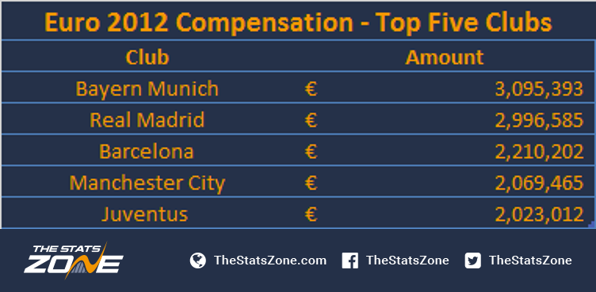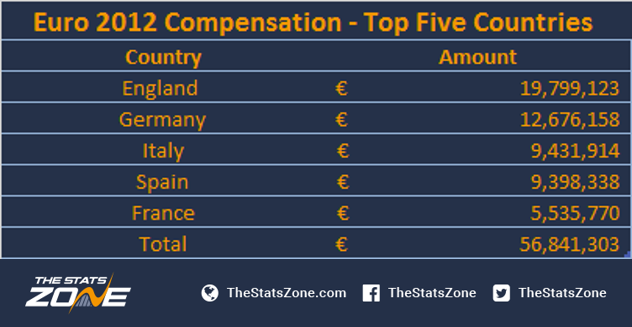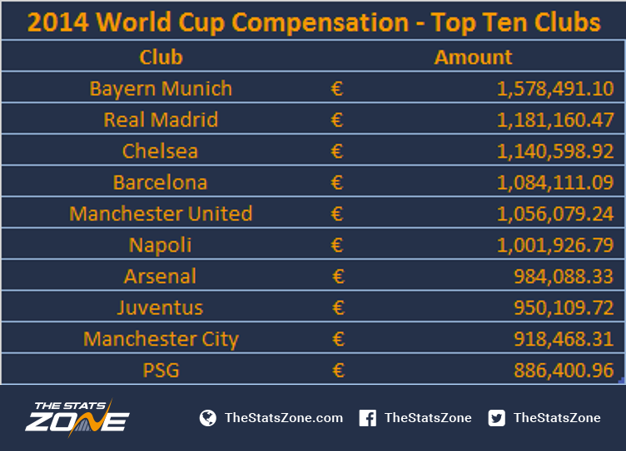“International football” – two words every club manager hates. Commentators often describe a manager hiding behind the sofa every time their player stays down too long or goes in for that brave 50/50 challenge; unfortunately, the weekend's World Cup qualification clash between Republic of Ireland and Wales showed us exactly why these fears exist.
The horror injury suffered by Republic of Ireland captain Seamus Coleman is something that no football fan wants to see. Medical insurance agreements are in place to cover such unfortunate events, and it has been revealed that FIFA will cover Coleman's wages for up to a year using their Club Protection Programme. In this article however, we want to look at the compensation payments that football clubs receive when their players represent their country in qualifying matches or tournament football.
The fees are in place to recognise clubs' involvement in developing players for international football, as well as reward them for the inconvenience of releasing their players. Here we will look at the data released for Euro 2016, which shows the amount that clubs received for their players representing their countries in the tournament (figures include qualifying matches that took place in 2014 and 2015). We will then look to see how these figures compared to Euro 2012, and the 2014 World Cup.
Euro 2016
It was confirmed last month that 641 European clubs received compensation for their players' involvement in Euro 2016 and the relevant qualifying matches. This is a significant increase on Euro 2012 (575 clubs) and even more so on Euro 2008 (180 clubs).
To break down the figures, a total of €150 million has been distributed in total, with €100 million being paid for the tournament itself and the remaining €50 million assigned to the qualifying matches. The average payment amount in qualification matches (per player, per match) ranged from €3,536 to €4,307, depending on whether a nation had played 10 or 12 qualification matches. During the tournament itself, the fees are paid per day and the averages differ depending on the category of each club (assigned by FIFA). These averages range from €2,410 (category 3 clubs) to €7,231 (category 1 clubs).
Firstly, we'll look at the top five European clubs in terms of compensation received:

Unsurprisingly, the top five is made up of clubs from the 'big five' European nations, with Juventus leading the way having received almost €3.5 million in compensation. Two Premier League outfits in Liverpool and Tottenham Hotspur follow, with European giants Bayern Munich and Real Madrid also propping up the table. It should be noted, however, that for such large clubs, these amounts are not altogether significant as they make up only a fraction of their total income; it is the smaller clubs that will receive the greatest benefit from these payments.
We'll now break the figures down in a different way. The following is the total compensation paid to each country, if you total up the figures distributed to their respective club teams:

The total received by English teams - which equates to 25% of the total amount paid - was over double that of Germany, who come in second. When considering the vast array of nationalities represented in English football, this is not an altogether surprising result, but there is still a significant gap compared with the other nations.
It's also noticeable that teams in Russia and Turkey were not far behind the total received by French clubs, so the 'big five' were close to being infiltrated in this respect.
With a significant portion of the compensation going to English clubs, we'll now take a closer look at how this was distributed amongst the current Premier League clubs:

14 out of the 20 clubs currently playing in the Premier League received over €1 million, and the total paid out reaches close to to €30 million. The remainder of the figure paid out to English teams was distributed to clubs further down the league pyramid, and it should be noted that the sum paid to Welsh club Swansea City is not taken into account when looking at the total figure for English teams, despite the fact they play in the Premier League.
Everton, who will miss out on international appearance fees for Seamus Coleman for the foreseeable future, are eighth on the list here, receiving almost €1.5 million in compensatory fees. When weighing up the loss of such a huge player, a similar figure for the World Cup 2018 qualification campaign will not provide the Toffees with much comfort, even when considering the additional assistance they will receive from the FIFA Club Protection Programme.
Euro 2012
For Euro 2012, 575 clubs received compensation for their contribution to the competition and the national team.
There was a total of €100 million distributed to all the 575 clubs, with €40 million assigned to qualifying matches and the remaining €60 million allocated to the actual competition.
The amount for qualifying matches varied between €3,494 and €5,241 dependant on the number of games the player played; whilst the figure stood between €2,265 and €6,795 per day for the tournament, dependent on the category of the club.
When we look below we can see the five clubs that received the most compensation from the agreement:

Once more we see teams you would expect make up this list, with German giants Bayern Munich receiving the largest compensation.
Next up, we will look at the top five Associations – England, Spain, Germany, France and Italy to see how the figures compare against each other:

For Euro 2012 compensation, clubs in England were once again way ahead of their rival countries, receiving nearly 20% of the total compensation figure set by UEFA and ECA. As many as seven English clubs received over the €1 million barrier, compared to just three in Germany, two in Spain and Italy and zero in France. The force and magnitude of the clubs in these countries is evident, with well over half the allocated amount of compensation money going their way.
2014 World Cup
The 2014 World Cup in Brazil also had club managers sweating, but the compensation may have gone some way to alleviating that stress. The deal at the time of the World Cup in Brazil saw €56 million allocated for compensation, which is set to significantly increase in the next two World Cups to approximately €170 million. In 2014, FIFA announced that a figure of approximately €1400 per player per day would be received by football clubs with players participating, an increase from the approximate €1200 daily rate of players in South Africa 2010.
Let’s take a quick look at which clubs were compensated the most as a result of the 2014 World Cup. The data supplied was in dollars, but using the current exchange rate they have been converted into Euros, so there could be minor fluctuations in terms of the figures:

Yet again, we see that Bayern Munich are the top dogs as they received the largest compensation, but it is around half of what they received for the Euro 2012 campaign; a curious statistics given the fact the World Cup is a more prestigious event. It is noticeable how the English clubs profit yet again, with four clubs inside the Top 10.
Compensation and finances in football can lead to big fallouts. All you have to do is look at the arguments over compensation payments for the 2022 World Cup in Qatar in recent times, or the debate in America about how the men play for money and the women for the glory; the women’s national team constantly outperforms the men, but receive a fraction of the money.
Compensation payments paid to clubs releasing players for international duty are on the rise, with €200 million forecasted to be paid out in total for Euro 2020. However, when looking at individual cases such as that of Seamus Coleman, the fees that Everton will receive for the World Cup 2018 qualification campaign will be scant consolation for losing one of their most valuable players, and one of the top right-backs in world football, for such a significant period of time.
